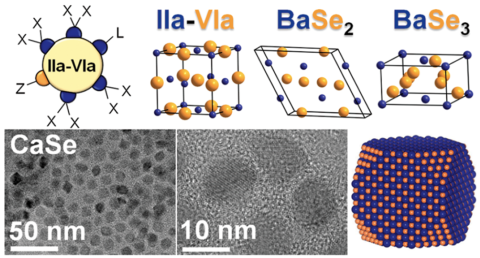Alkaline earth chalcogenides are a type of semiconductor that is of growing interest among scientists. They have a variety of possible applications such as bioimaging, LEDs, and thermal sensors. These compounds may also be used to make optical materials such as perovskites, which convert light into energy.
According to Javier Vela, Ames Lab scientist and the John D. Corbett Professor of Chemistry at Iowa State University, one reason these new materials are of interest is because, “they are comprised of earth-abundant and biocompatible elements, which make them favorable alternatives compared to the more widely used toxic or expensive semiconductors.”
Vela explained that more widely used semiconductors contain lead or cadmium, both elements that are detrimental to human health and the environment. Additionally, the most popular technique scientists use to synthesize these materials involves solid-state reactions. “These reactions often occur at extremely high temperatures (above 900 °C or 1652 °F) and require reaction times that can last anywhere from days to weeks,” he said.
On the other hand, Vela explained that “solution-phase (colloidal) chemistry can be performed using much lower (below 300 °C or 572 °F) temperatures and shorter reactions times.” So, the colloidal method Vela’s team used requires less energy and time to synthesize the materials.

Unit cells and electron micrographs of alkaline earth chalcogenide (AeCh) nanocrystals.
Vela’s team found that the colloidal synthesis method allowed them to control the size of the nanocrystals. Nanocrystal size is important because it determines the optical properties of some materials. Vela explained that by changing the size of the particles, scientists can influence how well the materials absorb light. “This means we can potentially synthesize materials that are more suited for specific applications just by changing the nanocrystal size,” he said.
According to Vela, the team’s original goal was to synthesize semiconducting alkaline-earth chalcogenide perovskites, because of their potential use in solar devices. However, to accomplish this goal, they needed a deeper understanding of the fundamental chemistry of alkaline earth chalcogenides. So, they chose to focus on these binary materials instead.
Vela said that their research fills a need to improve scientists’ understanding of photovoltaic, luminescent, and thermoelectric materials that are made of earth-abundant and non-toxic elements. He said, “We hope that our developments with this project ultimately aid in the synthesis of more complex nanomaterials, such as the alkaline-earth chalcogenide perovskites.”
Read the original article on Ames National Laboratory.







